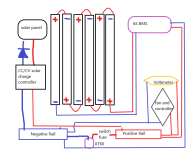CONSIDERABLE SHOUTING
10 kW
- Joined
- Jun 15, 2019
- Messages
- 815
I scrap a lot of stuff, and in my possession are tons of laptop lithium cells- mostly 2400-2500mah, rated 1 Amp of discharge cells that have consistent capacities made entirely of 2 brands. Charge to 4.2v no problem on basic opus chargers for info, have similar curves and rates of discharge, but because they're all resales their resistances are all over the map. Lowest are maybe 60miliohms, highest are up to 250. I easily have 100-120 of them, and that resistance has only increased since I salvaged them.
At the same time, I'm trying to start in this hobby properly and I wanted something to make to get started- and I have lots of 20-24v tools, so I thought about building some kind of backpack or carrier to use all these cells in one big, 24v nominal battery that could push 20-21 amps at peak by just having tons in parallel. But with that high of an IR, is there ANY reason to do so at all? From what I'm reading (and still learning), this idea would rapidly die on me because the high resistance cells would rapidly burn out. Or would it be a good idea from the standpoint of learning- and since I have everything sans BMS- to just make it, since 24v is relatively safe?
At the same time, I'm trying to start in this hobby properly and I wanted something to make to get started- and I have lots of 20-24v tools, so I thought about building some kind of backpack or carrier to use all these cells in one big, 24v nominal battery that could push 20-21 amps at peak by just having tons in parallel. But with that high of an IR, is there ANY reason to do so at all? From what I'm reading (and still learning), this idea would rapidly die on me because the high resistance cells would rapidly burn out. Or would it be a good idea from the standpoint of learning- and since I have everything sans BMS- to just make it, since 24v is relatively safe?


